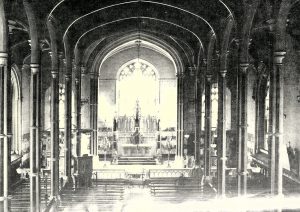Mortuary Chapel – A Momento [Church of our Lady and St. David Naas]

A new mortuary chapel was added to Church of our Lady and St. David Naas circa 1953. The Bishop of Kildare and Leighlin, Rev. Dr. Keogh, blessed the new chapel for Naas Church and the new Christian Brothers’ National School in late 1954. A memento programme was produced for this event, which was attended by Minister for Education Richard Mulcahy and Rev. P.J. Doyle P.P.
A digitised copy of the memento, with detailed information on the chapel and work involved, is available in pdf here: Mortuary Chapel Naas A Memento
The architect was Andrew A. Devane, who attended school in Killashee Convent and later at Clongowes before later receiving training under the famous American architect Frank Lloyd Wright. Mr. Laurence Campbell R.H.A. was the sculptor of the figure of the crucified Christ, with the contractors being Corcoran Bros. of Naas. Interestingly, much of the stone for the new chapel came Naas Jail with the demolition of the south wall beginning in early 1953. Each stone was subsequently transported by hand to the Church grounds.

Below is the contemporary news report from The Irish Press of 8 November 1954.
Bishop blesses school, chapel
Naas Ceremonies
The Irish Press Reporter, 8 November 1954
A period of endeavour and co-operation of which priests and people of Naas have reason to feel proud was brought to a conclusion yesterday when Most Rev. Dr. Keogh, Bishop of Kildare and Leighlin, blessed a Christian Brothers’ National School for boys and a new chapel for Naas Church.
The new £21,000 school has accommodation for 336 boys and has a big playground and football field. Very Rev. P.J. Doyle, P.P., Naas, at a luncheon after the ceremonies, having paid tribute to Most Rev. Dr. Keogh’s devotion to priests and people, said that that figure of the Crucified Christ in the new mortuary chapel, the work of Mr. Laurence Campbell, R.H.A. was “one of the greatest pieces of sculpture executed in Ireland for a long time.” Most of the stone for the new chapel came from Naas Jail, which was last used to house Land League prisoners.
Most Rev. Dr. Keogh said that the new mortuary chapel was a work of art. “Good, honest, stone building in a church is a beautiful thing,” he said, “but unfortunately the craft is in the process of being lost.” General Mulcahy, Minister for Education, said that Most Rev. Dr. Keogh had done an amount of work that was not only an inspiration to his Diocese, but to the people outside it. Paying a tribute to the work of the Christian Brothers and other teachers, he said that the Easter Rising of 1916 was called the “Schoolmasters Rebellion.” There was no more worthy monument to express the achievements of those who fought for freedom than schools which safeguarded Irish tradition.
Most Rev. Dr. Keogh was welcomed at the new school by Rev. Brother E.C. McKenna, Superior, Christian Brothers, Naas. The ceremonies began with Solemn High Maas at which Most Rev. Dr. Keogh presided. Right Rev. Monsignor W. Miller P.P., V.F., Droichead Nua, assisted at the Throne and Rev. G. Brophy, C.C., Naas was celebrant. Deacon was Rev. P.J. Brophy, St. Patrick’s College, Carlow, and the Rev. L. Newman, C.C., Naas was sub-deacon. Rev. E. Shine, Droichead Nua, was Master of Ceremonies.
Architect of the new school was Mr. B. Boyd Barrett and Mr. J. Tyrrell, Naas, was the contractor. Architect for the Chapel was Mr. Andrew Devane and the contractors were Messrs. Corcoran Bros, Naas. The mosaic ceiling was done by Italian Artists brought to this country by Messrs. Crean and Son, Roscommon. Other contractors for the chapel were: stained glass – Hogan Studio, Dublin; Altar and catafalque pillars – Earley Studio, Dubiln; entrance grille – Messrs J. and C. McGloughlin, Dublin; candlesticks of Altar and catafalque – Mr. Ferguson Peacocke, Dublin.
